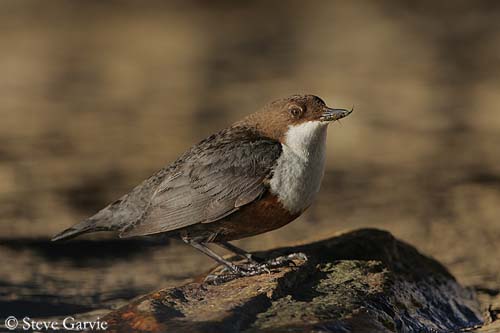
The White-throated Dipper, the bird flying underwater!
Passeriformes Order - Cinclidae Family
Hard for us to believe the facts, but the White-throated Dipper, or Dipper, is able to walk and fly underwater.
This bird frequents fast, shallow water. Often seen perched on rocks in the middle of rivers or mountain torrents, it may disappear abruptly.
Where is it? The Dipper is hunting underwater after a brief dive from the perch, by bobbing back to the surface.
White-throated Dipper is an amazing bird, unique by its behaviour.
To hear its melodious song with the sweet noise of the running current in background is something superb.
Dipper is the soul of the mountain torrents, displaying its white breast from rock to rock, and challenging the fast-flowing waters.
Photographers:
Steve Garvie
RAINBIRDER Photo galleries
Eugène Montocchio
Galerie Photos Nature
Other pictures and text by Nicole Bouglouan
Sources:
WRENS, DIPPERS AND THRASHERS by Brewer David – illustrated by Barry Kent Mackay- Yale University Press - ISBN: 0300090595
THE HANDBOOK OF BIRD IDENTIFICATION FOR EUROPE AND THE WESTERN PALEARCTIC by Mark Beaman, Steve Madge - C.Helm - ISBN: 0713639601
THE COMPLETE BOOK OF BRITISH BIRDS – Written by “Royal Society for the Protection of Birds” experts - Préface de Magnus Magnusson - Michael Cady- Rob Hume Editors - ISBN: 0749509112
Pájaros de España (JL Beamonte)

Dipper (Cinclus cinclus) has plump body. It is about 18-20 cm long, and weights about 65 grams.
Upperparts contrast strongly with the white chin, throat and breast. The slate-grey back shows scaly effect. Head and nape are brown. The white breast is bordered by narrow chestnut band. Belly and vent are dark greyish-brown. Short wings and tail are dark-coloured.
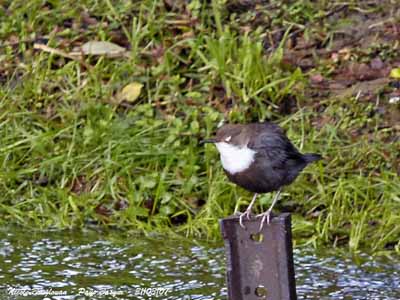
The straight bill is black. The brown eyes are surrounded by pale eyelid, and protected from water by whitish nictitating membrane, visible when the bird blinks. Legs and unwebbed feet are dark brown.
Both adults are similar.
The juvenile is greyer above and white speckled with grey below.
Dipper has soft and dense plumage providing good insulation in the water.
Dipper frequents fast-flowing shallow streams, rivers and torrents with rocks. It needs bridges or rocky faces on the side for nesting. This species may adapt to human developments on the riverbanks when the stream crosses a town. It may be found sometimes in lakesides, but mainly in upland areas.
Populations move to lower elevation in winter, and may be seen even along the coasts.
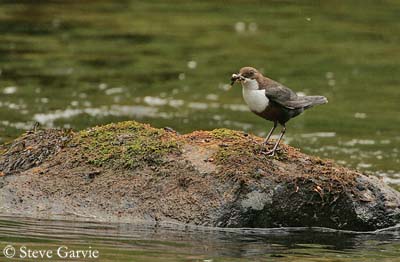
White-throated Dipper feeds primarily on aquatic invertebrates, larval forms of aquatic insects, small fish, salmon eggs and tadpoles.
It hunts in the water, and often underwater. Dipper often perches on rocks in mid-river, searching for preys. It also flies low over the water with rapid wing-beats.

Several techniques are used for feeding. The bird wades in shallow water, submerging sometimes the head to search prey. When the water is deeper, it swims down to the bottom thanks to the powerful wings.
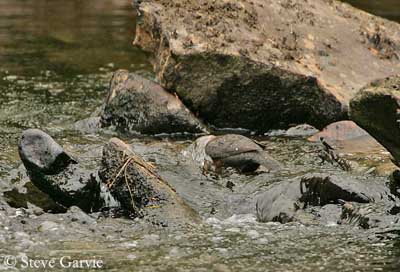
Then, the Dipper walks on the bottom by grasping stones. It often walks against the current, with the head downwards to locate prey, and the current’s force against the bowed back keeps it on the river bed. But the wings are the main tool of locomotion under water, and it often walks with semi-open wings.
We often see the Dipper perched on rock in mid-river, looking at the water. It performs rapid bowing movements, enhanced by the pure white of the breast. Once the prey is detected, it dives head-first into the water, even into turbulent and fast-flowing water. When on the bottom, it turns up stones and pebbles, in order to disturb small invertebrates.
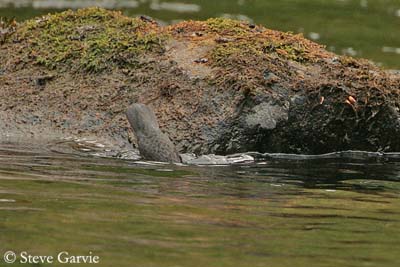
After diving, it often floats downstream over a short distance with partly open wings before emerging.


During courtship displays, territorial disputes or when excited, Dipper still bobs the whole body up and down, and also dips frequently, exposing the white breast.
Another display is a rapid blinking, allowing to see the white eyelid repeatedly flashed, and the whitish nictitating membrane. If the bird is disturbed or alarmed, blinking occurs very rapidly, at rate of one blink a second!
Dipper flies fast with whirring wing-beats over the surface. Its flight is direct and low from the water, following the course of the stream, river or torrent. The flight displays are performed high above the territory.

While flying, the Dipper utters its sustained warbling song, a very sweet, long, liquid warble, given by both sexes. The female’s song is less melodious and rather scratchy than the male’s song. This song may be uttered from a perch too, and sometimes at night.
The call is loud and penetrating, a metallic and rasping “zink” or “zitzit” often repeated when perched or in flight.

This species is often seen solitary or in pairs, but during winter, several birds may roost together in sheltered place or under a bridge.
The nest is a bulky structure situated under a bridge, in cavity in tree-stump, in ledge behind waterfall, hole in walls or crevices in rocks on the riverbank. Both sexes build it. It is a domed nest, with a wide, downwards-pointing side-entrance. The outer part of the nest is made with mosses (moistened by immersion in the water), grass, stems and leaves. The cup is lined with fine rootlets, leaves and hair. The nest is often just above the water.
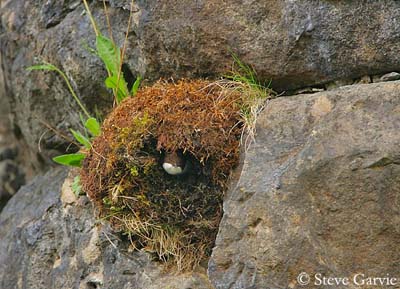
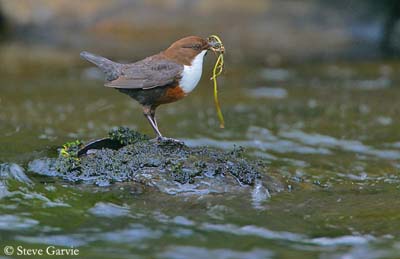
Breeding season occurs in spring, with the laying in March-April.
The female lays four to six glossy white eggs. Incubation lasts about two weeks by female alone. The male guards the nest when the female is feeding away from the nest, but it also feeds her regularly at nest.
The altricial chicks are fed by both parents. Young fledge about 24-25 days after hatching.
Dipper may produce two or three clutches, using the same nest. They usually are monogamous.
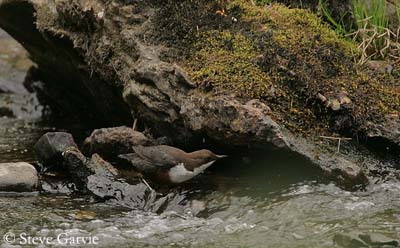
The White-throated Dipper is largely sedentary in Britain and probably in Western Europe and North Africa too, with some post-breeding dispersions by young birds, and small altitudinal movements. But populations of Scandinavia are migratory, moving towards south-east into southern Finland and the Baltic republics, and sometimes into Denmark.
The Ural populations are partially migratory, and Central Asian populations perform altitudinal movements.
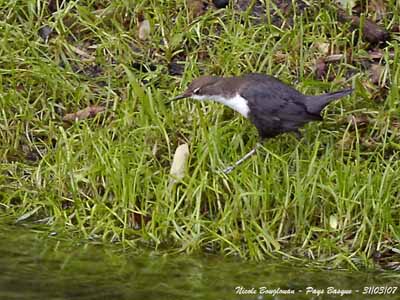
We can find several subspecies which differ in plumage colour, mainly the underparts.
All the species which belong to the Cinclidae Family, Order Passeriformes, have the same behaviour.
We find four other species which share with the White-throated Dipper the wide world range: Brown Dipper (Cinclus pallasii), White-capped Dipper (Cinclus leucocephalus), Rufous-throated Dipper (Cinclus schulzi) and American Dipper (Cinclus mexicanus).
Dipper’s populations are fairly stable, but they are vulnerable to bad water quality due to various pollutions such a mining, deposition of silt by deforestation or agricultural practices and eutrophication from pesticides. But in suitable habitat, this species may be fairly common.
